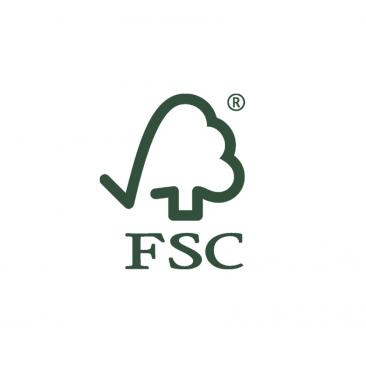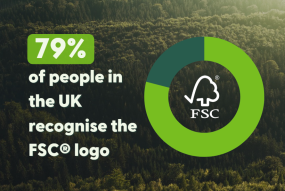
Chain of custody standards
Chain of custody control systems
-
Transfer system
The transfer system provides the simplest approach for determining output claims by transferring the FSC claims of input materials directly to the output products. Eligible materials must be segregated from ineligible materials to ensure that the link between input and output material is preserved throughout all stages of processing.
This system allows outputs to be sold with an FSC claim that is identical to, or lower than, the input material category and, if applicable, the lowest associated percentage claim or credit claim. It can be applied to all types of product groups, FSC claims, and activities.
-
Credit system
This is a volume-in/volume-out system where the quantity of “contributing inputs” - FSC-certified material and/or reclaimed material - determines the quantity of outputs that can be sold (invoiced) as e.g. “FSC MIX Credit” and labeled as FSC MIX. This is usually managed by using contributing inputs to build credits in a credit account for outputs, applying a conversion factor to the former to account for waste and changes in units of measure. All the non-certified virgin (i.e., not reclaimed) material that is mixed with contributing inputs in the manufacturing process must be controlled wood.
For example, when a sawmill operates under the credit system, it will typically have credit accounts for two product types: 1) the lumber that is its main product; and 2) the residual chips and sawdust - that are a by-product and can be used to make paper and fibre-based wood products like particleboard and medium-density fibreboard (MDF). When the sawmill buys a given quantity of logs from FSC-certified forests, it applies two separate conversion factors to the quantity to build credits in a lumber account (where the unit of measure is board feet or cubic meters) and a residuals account (where the unit of measure is dry metric tons). When it sells FSC MIX products of either type, it deducts the volume sold from the appropriate account. As the credits in its accounts run low, the sawmill can buy more FSC-certified logs and build the accounts back up. Thus, a credit account is a bit like a bank account - you can’t withdraw money that isn’t there, and if you run out, you have to deposit more in order to make future withdrawals.
Another example would be if a paper company uses three types of inputs in its manufacturing: chips from virgin timber, sawmill residuals, and post-consumer recycled paper. The company can build credits in its paper account based on the volume of FSC-certified chips, FSC-certified residuals (If these residuals come from a sawmill that is using the credit system, then the residuals will be “FSC MIX credit” instead of “FSC 100%” (i.e., deriving directly from FSC-certified forests)), and reclaimed material it purchases, applying the appropriate conversion factors to the latter to calculate the quantity of the former.
In both cases, all the non-certified virgin chips and residuals coming into the manufacturing process must be controlled wood
-
Percentage system
The percentage system is like the credit system in many respects: the contributing inputs are the same as is the requirement that all virgin inputs have to be controlled wood. Instead of using volume-in and volume-out, however, the amount of contributing inputs relative to the overall quantity of inputs is used to calculate a percentage of FSC content, and this is reported when products are INVOICED (B2B) as e.g. “FSC MIX [XYZ]%,” where XYZ is the percentage of contributing inputs, but can only be LABELLED as FSC MIX when this percentage is a minimum of 70% .
A major difference between the credit and percentage systems is that ALL the manufacturing outputs can bear the FSC MIX label if there is a minimum of 70% of FSC 100% (or Mix Credit) and/or FSC-reclaimed content, and you cannot use the FSC MIX label at all unless this threshold is met. The reason for this is to give manufacturers an incentive to increase their FSC-certified supply so they can meet the threshold.
For example, if a sawmill buys 25% of its logs from FSC-certified forests (FSC 100%) and the remaining 75% is controlled wood, it could INVOICE all of the lumber it makes as “FSC MIX 25%,” but it couldn’t use the FSC LABEL on any of it. However, if it bought 80% of its logs as FSC-certified and the rest as controlled wood, it could invoice all the lumber as “FSC MIX 80%,” and it could label all the lumber as FSC MIX.
In the same way, if a paper manufacturer’s inputs were 20 tons of virgin chips, 50 tons of virgin residuals, and 30 tons post-consumer recycled paper, and half of the chips were FSC-certified, and the residuals were all controlled wood, then the percentage calculation would be 10 tons chips + 30 tons recycled over 100 tons total = 40%. The company could sell all the paper as “FSC MIX 40%” but couldn’t put the FSC label on any of it. However, if the residuals were also FSC-certified, it would reach a total of 90%. The company could sell this paper as “FSC MIX 90%” and label all of it as FSC MIX.
Core labour requirements
In 2021 FSC introduced new core labour requirements, as part of the chain of custody certification standard, to provide added protection for the rights of workers in all FSC-certified operations.
FSC certificate holders must demonstrate conformity to the requirements, which cover the abolition of child labour, elimination of all forms of forced or compulsory labour, elimination of discrimination with respect to employment and occupation, upholding freedom of association, and the effective recognition of the right to collective bargaining.
Guidance for certificate holders can be found here.
Advice and interpretations
A directive includes all advice issued in relation to a single standard. The relation to a standard is reflected in the document code. An interpretation is a formal normative clarification provided by the FSC Performance and Standards Unit to requirements included in documents of the FSC Normative Framework.
Directives
FSC Directive on Chain of Custody Certification (FSC-DIR-40-004)
FSC Directive on FSC Controlled Wood (FSC-DIR-40-005)
FSC Directive on Project Certification (FSC-DIR-40-006)
Interpretations
Chain of Custody Interpretations
Controlled Wood Interpretations

Online training
We offer free online training for UK certificate and licence holders. Our training courses are designed to introduce and explain the FSC system and how it relates to your business or organisation. Our FSC chain of custody online training course provides organisations the opportunity to easily access and learn about FSC Chain of Custody certification.

Trademark use
The FSC trademarks are the primary communication tools for FSC certificate holders to demonstrate that their products meet the standards set by FSC. Compliance with the FSC trademark standard is mandatory for all FSC certificate holders making use of the FSC trademarks.

News
News, case studies and technical updates from FSC UK.

Consumer Insights
The latest consumer UK and global FSC consumer survey results.

Forest Matters
Subscribe to the monthly newsletter from FSC UK and catch up with past issues.
